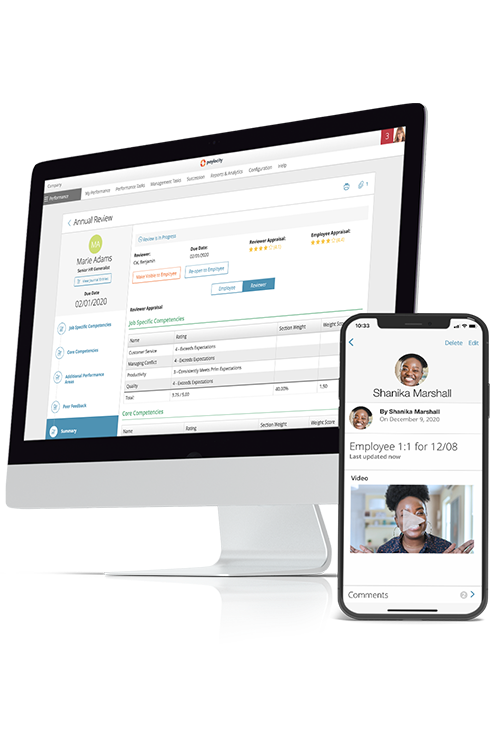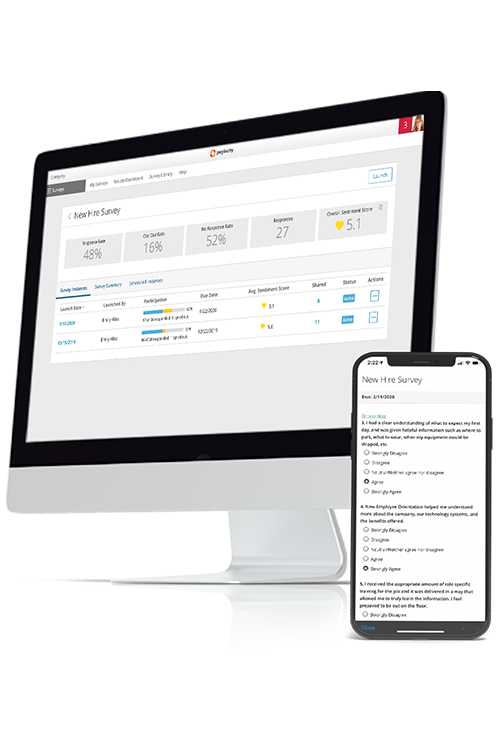resources
Coaching vs. Managing: What are the Differences? And How to Embrace Both
June 19, 2023
Managers or coaches? The best leaders are both. Learn how to embrace both roles to create a more productive and engaged workforce.
Blog Post

Modern workers don’t just want to be managed — they also want to be coached.
No longer is it enough for managers to simply delegate tasks. With five active generations in the workforce — including millennials, the largest slice of the workforce and Gen Z, the fastest-growing demographic in the workforce — much more is expected of today’s leaders, including training and development opportunities.
You need managers and coaches to have an effective workforce. We’re going to dive into how to build these essential skills, but first, let’s explore what’s the difference between the two.
Key Takeaways
- Managers focus on direction and control, while coaches focus on development and empowerment. You need leaders who can do both for a productive and engaged workforce.
- Managers need to be able to communicate effectively with their team members to give clear instructions and resolve conflicts. Coaches need to be able to listen actively and ask open-ended questions.
- You can nurture strong coaches and managers by focusing on communication skills, providing professional development opportunities, and leveraging mentors at your organization.
What Is the Difference Between Managing and Coaching?
While “managers” focus primarily on authority and directing, “coaches” focus on teaching and facilitating. The modern manager must wear both hats to bring the best out in their employees.
Think of coaches and managers as two sides of the same coin: Both drive employee efficiency, efficacy, and ultimately performance both on an individual and team level. But their roles and approaches differ in a few important ways.
Here's a few tactical differences:
|
Manager Duties |
Coach Duties |
|
Managers capture employees’ potential by:
|
Coaches bring out the best in employees by:
|
Understanding the responsibilities is one thing but recognizing when to apply them is another. It’s important to know which situations call for donning the manager hat and which call for the coaching hat.
When to Be a Manager, and When to Be a Coach
You may be a seasoned manager and an all-star coach — but when do you need to step into either role?
Situations that Call for Employee Management
There’s no question coaching skills are valuable to the modern manager, the employees they supervise, and the organizations they work for. At the same time, there’s a time and a place for a manager to focus on their role and responsibilities as a director.
Situations that require a manager’s expertise include:
- Deciding which employee can take on the role of team lead
- Onboarding a new employee, including providing logins and passwords, orienting the employee to their work environment, and introducing them to team members
- Scheduling team meetings, providing an agenda, and leading the meeting
- Arranging formal performance reviews and documenting the results
- Defining team goals and holding the necessary parties accountable
- Guiding decision-making and problem-solving during an emergency, such as a delayed shipment of essential supplies that requires immediate action
- Establishing project deadlines and following up with team members to make sure they are met
Situations That Call For Employee Coaching
While these administrative and project management duties are necessary, today’s workers also expect leadership to provide them with personal and career growth opportunities. To make this a reality, managers must recognize when their coaching skills are required.
Some situations that call for a manager to step into a coaching role include:
- Sitting down with an employee one-on-one to give feedback on a recent task
- Helping an employee develop soft skills that would enable them to reach their full potential
- Assisting an employee set professional development goals and find resources to achieve them
- Holding a workshop for a team or department to improve collaboration efforts
- Asking an employee open-ended questions to identify what went well, what could be improved, and what next steps they’d like to take on a project.
What Skills Are Needed to Be an Effective Coach and Manager?
A strong performance management model requires supervisors to act as both managers and coaches. While there is some overlap in each role’s skillsets, mastering the unique qualities of both makes for a more effective leader.
Have your leaders focus on developing the following skills to grow their managing and coaching abilities:
|
Manager Skills |
Coaching Skills |
|
|
What unites coaching and managing is the need for highly advanced communication skills, including awareness of both verbal and nonverbal communication, listening, clarity, and more. These skills are just applied in different situations.
Tips for Building Coaching and Managing Skills in Your Organization
So, we've learned the difference between coaching and managing, why they’re both important, and the skills required to do it well. Now how do you go about fostering great coaches and managers in your workforce?
1. Focus on communication skills
The foundation of both coaching and managing is communication.
That’s why it’s critical to invest in building strong communication skills. There are many ways to go about this (a lot of it involves practice), but here are a few ideas:
- Lead by example. Hone your own communication skills and put them into practice. Real and relevant examples can be powerful teaching tools.
- Create opportunities for managers to exercise their skills. Standardize regular one-on-ones and team meetings so managers have consistent opportunities to develop their communication skills.
- Implement an employee development program. Formalize a development program as part of your talent management strategy, and make managers an essential component. This creates space for genuine coaching opportunities (Bonus: It provides highly coveted career development for your non-managers as well).
- Simplify with structure. There are a variety of frameworks for coaching and managing, like GROW (Goal, Reality, Options, Way Forward) or the Communication Strategy Framework. Find one that suits your organization, and encourage your managers to use it to help structure their conversations.
2. Provide professional development opportunities
It's one thing to talk about career development theoretically, but actually dedicating work hours to growing these skills signals that it’s a priority to your organization. Plus, it allows HR pros to play a more direct role in fostering strong managers and coaches.
Consider launching your own in-house manager training program tailored to your organization. Leverage a learning management system (LMS) to house your coursework and assign your managers to complete the curriculum. Encourage participants to engage with the materials, making time for group discussions or individual journaling sessions where employees can reflect on what they’ve learned.
Worried about the time commitment? A training program could be as simple as assigning a book or online resource about managing/coaching, then meeting to discuss takeaways.
3. Take advantage of your role models
It's often best to learn by example. Consider having some of your all-stars mentor other managers, or host a training session for your organization.
Keep whatever materials are generated from these role model courses (recordings, PDFs, and online resources, for example) and store them in your LMS. That way, your future managers can reap the benefits of this expertise as well.
Tools to Facilitate Employee Coaching and Managing
When it comes to nurturing the best managers (slash coaches), you’re not alone.
Thanks to HR technology that can be integrated into the platforms that workers are already familiar with, managers have resources to make this tall order much more, well, manageable.
- Integrated employee engagement tools act as a one-stop shop where employees can message and interact with their managers and colleagues anytime, anywhere.
- Centralized performance management and peer recognition make the feedback and evaluation process well-rounded and breaks the top-down mold.
- Mobile HCM platforms offer an easily accessible experience that integrates seamlessly into the programs that employees use every day. And leadership now has tools to monitor employee performance and provide that continuous feedback today’s workers crave.
- With an integrated learning management system (LMS), managers can foster learning and development through custom training videos created and shared by workers, a library of on-demand training content tailored to different learning styles, and dashboards that track employee progress and assign courses based on an employee’s unique challenges and focuses.
Integrated HR tools, like Paylocity’s all-in-one HR and Payroll software, make for a seamless experience across roles and departments, setting the stage for successful managing and coaching.
Request a demo of Paylocity’s HR software to learn more about how our solution can empower your managers to coach, and manage, effectively.




